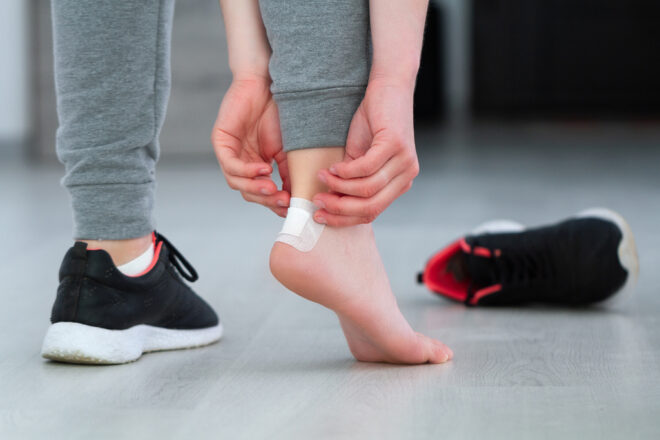Any blister can be unpleasant, but blisters between toes can be especially bad. Even more so if you’re training for a marathon or another long race.
In today’s post, we talk about what blisters are and discover common types of blisters among runners.
We’ll also look at how to cure blisters on feet quickly. Read on to find out more.
In This Article:
What Are Blisters?
Blisters are bubbles filled with fluid that appear on your skin, often due to friction. However, some blisters can appear without friction. The fluid in a blister may be clear or contain some blood.
Since blisters are not all the same, it’s important to consider their location and how they have arisen. That way, you can treat them accordingly and prevent them in the future.
Since runners often develop blisters on their feet, let’s take a closer look at the types of toe blisters.
Types of Toe Blisters
You can differentiate toe blisters by cause or severity. First, let’s look at the different types of blisters on toes according to what causes them:
- Blisters between toes not caused by friction. Medically known as interdigital blisters, these often appear because of an infection or allergy.
- Blisters in between toes caused by friction. If the toes press each other or there is pressure from a shoe, the resulting friction may lead to a blister.
- Pinch blisters between toes. When one toe is curled under another toe and is pinched, a blister may form. Wearing tight running shoes can also lead to pinch blisters if they press against the toes.
Regardless of their location, some blisters are more serious than others. Depending on their severity, toe blisters can be:
- Clear blisters. These bubble-like blisters are filled with serum, the clear, watery component of blood. Although they can be uncomfortable, they tend to be the least severe.
- Blood blisters. Blood blisters are dark red or purple. They occur when the blood vessels beneath the blister get damaged and leak into it.
- Infected blisters. Both clear and blood blisters can become infected. Infected blisters can be red, swollen, and painful. Pus may form, and they may smell bad. Infected blisters require prompt medical treatment.
Why Do You Get Blisters When Running?
From sweaty feet to warfare agents like sulfur mustard, blisters can have many causes. But unless you are running through a battlefield, the causes behind blisters in between toes are common and, as we’ll see later, often preventable.
Here’s what causes a blister in between the toes in most runners.
Fungal and bacterial infections
Several types of foot fungus may cause foot blisters. Athlete’s foot is the most common, and it also comes with itching feet. It occurs if you run wearing damp socks. Exposing bare feet to a warm and humid environment may also cause the condition.
Athlete’s foot treatment involves washing and drying your feet and applying an antifungal product. Alternatively, you can soak your feet in salt water or diluted vinegar. Depending on the severity of the condition, it may take 2 weeks or longer to cure an athlete’s foot.
Bacterial skin infections like cellulitis may cause blisters in addition to redness, swelling, pain, and other symptoms. Cellulitis is not contagious, but it may enter the body through an injury or wound.
The viral infection hand-foot-and-mouth disease may also cause blisters on the feet, often as part of a rash that may also affect the hands. Other symptoms include fever and mouth sores.
Sunburn or burns
Do you enjoy running barefoot or in sandals? It can feel liberating. But if you do it in the heat of summer or at a high altitude on a sunny day, your feet may get sunburned. As a result, a blister may develop in between your toes.
Second-degree burns may also cause blistering, according to MedlinePlus.
Wrong shoes
Running in ill-fitting shoes is one of the most common causes of developing a blister between the toes. This can happen if your shoes allow your toes to move too much as you run.
Or if the front of the shoe is so tight that it pinches your toes. The longer you walk, run, or train in the wrong shoes, the higher the risk of developing a toe blister.
Friction
When you find a blister between toes, most of the time, it’s because of friction. If your toes rub against your socks or shoes for a long time, a blister is likely to develop.
Insect bites
Getting bitten by an insect can trigger an immune response that leads to a toe blister. Running in sandals or bare feet makes you more likely to suffer a toe blister due to the insect bite.
Feet or skin conditions
Allergic contact dermatitis occurs when the immune system overreacts to an allergen like latex rubber. It causes severe skin irritation, including blisters, that may develop several days after the initial contact.
Another condition that may cause blisters on the feet is dyshidrotic eczema (DE) or acute palmoplantar eczema. Common DE causes include frequently sweaty feet or allergies. However, this condition typically leads to small, fluid-filled blisters on the soles of the feet rather than the toes.
A rare inherited skin disorder that may lead to blisters on the feet is epidermolysis bullosa (EB). People with this condition have skin that blisters easily. These blisters often occur on the hands and soles of the feet. EB can range from mild to severe. Living with this condition may require special medical care.
Frostbite
You may also develop blisters if frostbite affects your feet. Once you return indoors and the skin begins to warm, painful blisters may appear. Similar to regular blisters, you shouldn’t burst blisters after frostbite.
Next up, let’s see how to treat blisters between the toes.
Treatments for Toe Blisters
Should you pop a blister on the toe to encourage healing? Not really.
The National Health Service and other reliable sources recommend against bursting a blister or peeling off the skin of a burst blister. This can increase the risk of infection as bacteria may enter the skin.
Most blisters can be treated at home following a simple care routine. Here’s how to cure blisters on your feet quickly:
1. Cover the blister with a bandage.
2. Reduce friction by taking a break from running and changing your socks and shoes. Rest is a crucial part of the healing process.
3. Walking without shoes when possible can promote healing.
4. Treat broken blisters with Epsom salt baths or by simply soaking your feet in warm water. After bathing your feet, apply a clean bandage.
Infected blisters require a visit to your doctor, who may prescribe an antibiotic or antifungal cream together with instructions on how to get rid of them.
Signs of an infected blister include redness, pain, swelling, pus, and fever.
Best Ways to Prevent Feet Blisters When Running
Knowing how to get rid of blisters is useful. But preventing foot blisters in the first place – not just in between toes but over your entire feet – is even better. And it’s not that hard, either. Here are the main steps you want to follow.
Lubricants
If two of your toes rub together or a particular area of your feet is prone to blisters, consider applying a lubricant like petroleum jelly. Lubricants can prevent blisters resulting from friction. They are especially useful during long runs.
Right socks
Wearing nylon or moisture-wicking socks can prevent blisters on your feet, according to the American Academy of Dermatology Association. Wearing two pairs of socks instead of one can provide more protection. This holds true even for regular socks. So make sure to put on an extra pair before heading out for a run.
Taping
You can also wrap the toes that rub against each other in adhesive tape. Some runners also wrap the tape around the area prone to blisters.
Right running shoes
To prevent foot blisters, wear running shoes that are neither tight nor loose. Your shoes should fit properly. For a good fit, go to a specialty store that offers gait analysis.
Keep your skin dry
Wet, sweaty skin promotes the formation of blisters. This is true even if you wear the right shoes and socks or tape your toes.
Avoid running with bare feet in moist conditions, such as on wet grass or when the humidity is high. If you run indoors on a treadmill, the changing room may be warm and wet, promoting blisters. Take a towel with you to dry your feet before slipping on your shoes.
Do not remove calluses
Calluses occur naturally on your feet because of friction. While calluses may be unsightly, think twice before removing them. Doing so increases the risk that a blister will develop in that spot.
Takeaways
In the end, blisters are common in the lives of runners but by no means inevitable.
- Don’t pop blisters, or they may become infected.
- Cover blisters with a bandage and reduce friction.
- Take salt baths and dry your feet to relieve itchiness and other uncomfortable symptoms.
- Give your blistered feet a rest to help the skin recover and avoid worsening symptoms.
- Prevent blisters by wearing the right shoes, two pairs of moisture-wicking socks, and using lubricants.
- Painful, swollen, pus-filled blisters are infected and require medical care.
References:
- Hoffman, M.D., 2016. Etiological foundation for practical strategies to prevent Exercise-Related foot blisters. Current sports medicine reports, 15(5), pp.330-335.
- Scheer, B.V., Reljic, D., Murray, A. and Costa, R.J.S., 2014. The enemy of the feet: blisters in ultraendurance runners. Journal of the American Podiatric Medical Association, 104(5), pp.473-478.
- Knapik, J.J., Reynolds, K.L., Duplantis, K.L. and Jones, B.H., 1995. Friction blisters: pathophysiology, prevention and treatment. Sports Medicine, 20, pp.136-147.
- Lipman, G.S. and Scheer, B.V., 2015. Blisters: the enemy of the feet. Wilderness & Environmental Medicine, 26(2), pp.275-276.
- Lipman, G.S., Ellis, M.A., Lewis, E.J., Waite, B.L., Lissoway, J., Chan, G.K. and Krabak, B.J., 2014. A prospective randomized blister prevention trial assessing paper tape in endurance distances (Pre-TAPED). Wilderness & Environmental Medicine, 25(4), pp.457-461.














